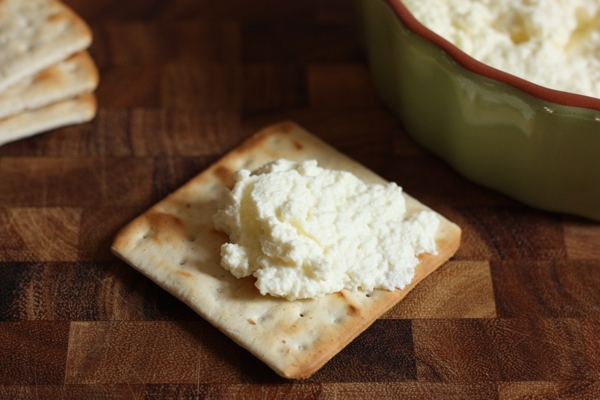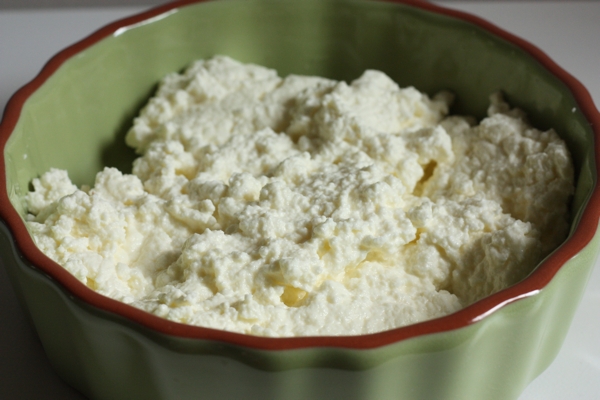I realize I’m a little late to the homemade ricotta game. Other food bloggers have already posted about this amazingly simple homemade cheese. And I’ve made it myself, quite often. But I’ve never been quite satisfied with the results.
Only during our recent food-focused travel to Tuscany did I realize why: I love the soft, tender, creamy Italian version of ricotta cheese. My previous experiments turned out cheese with large, dry curds and a firm texture. Delicious, but not the sensory experience I was after.
So I scouted around to find different recipes and techniques for making homemade ricotta. Some called for adding buttermilk or yogurt, which added a tang I didn’t love. Others called for stirring the milk mixture, which created larger, clumpier curds than I had in mind, or straining the ricotta for an hour or more, which created a firmer texture.
The proportion of ingredients for this recipe comes from Smitten Kitchen; I’ve made some adjustments to the preparation method to yield a homemade ricotta that’s light, delicate and creamy, just the way I like it.
It’s super easy to make ricotta cheese at home: The formula is dairy (milk and/or cream) + acid (lemon juice) + heat (190 degrees). You’ll need a thermometer, a colander or strainer and 2 layers of cheesecloth. Use the freshest local milk and cream you can find (and avoid cream that has thickeners or stabilizers).
So, what do you do with homemade ricotta? As Deb at Smitten Kitchen notes, you simply can’t go wrong schmearing homemade ricotta cheese onto slices of toasted bread with a generous sprinkling of sea salt and a glug of very good olive oil. I like to toss freshly cooked pasta with pesto and serve it in bowls with a giant spoonful of fresh, room-temperature ricotta cheese and a grind of fresh black pepper. Try ricotta as an alternative to mozzarella on a platter of perfectly ripe summer tomatoes.
My homemade ricotta recipe is unsalted, so you can serve a dollop over fresh berries with a drizzle of local honey. Now that I’ve got the technique down, I plan to make fresh ricotta cheese at home all summer long. 
homemade sweet and creamy ricotta cheese recipe
3 1/2 cups whole milk
1/2 cup heavy cream
3 Tbsp. freshly squeezed lemon juice
Line a colander with two layers of cheesecloth, and place it in a larger bowl to catch the whey. In a medium heavy saucepan, combine the milk and cream; cook over medium heat, stirring occasionally, until the mixture reaches 190 degrees. Remove the pan from the heat and quickly stir in the lemon juice; watch in amazement as the mixture begins to separate into soft, small curds and watery whey. Let the mixture stand—this is key: do not stir—for 5 minutes, then use a strainer to gently lift the solids into the cheesecloth-lined colander. Pour any remaining liquid into the colander and let the mixture drain for 30 minutes, max, for tender, light ricotta, or up to an hour for a firmer, schmear-able ricotta. Salt the ricotta to taste if you'd like. I prefer it unsalted, so I can add seasoning as I use it.
I've kept homemade ricotta in the refrigerator for about 10 days with no problem. Keep the whey, too—you can use it in place of water or milk to make pancakes or biscuits or oatmeal, or add it to your morning smoothie (whey's easily digestible proteins and amino acids are good for you).







Reblogged this on Living and Lovin.
Anyone who really likes ricotta (and I think maybe you do!) has my vote – and to make it for ourselves so simply, now that’s the ultimate treat Tell me, what do you store it in to maintain its freshness for ten days? But this much wouldn’t last ten days?
Tell me, what do you store it in to maintain its freshness for ten days? But this much wouldn’t last ten days?
You’re right: homemade ricotta is so good it doesn’t stick around long. And this ricotta recipe yields just about a cup. I use very fresh milk and haven’t had trouble keeping it longer than just a few days.
We made some in the hot press. It worked pretty well but was too much trouble to do regularly (we don’t eat a lot of ricotta). If one likes it a lot, it is a very good thing to do.
Best,
Conor
Pingback: Summery basil-chevre appetizer. | writes4food | recipes and wisdom from a Midwestern kitchen